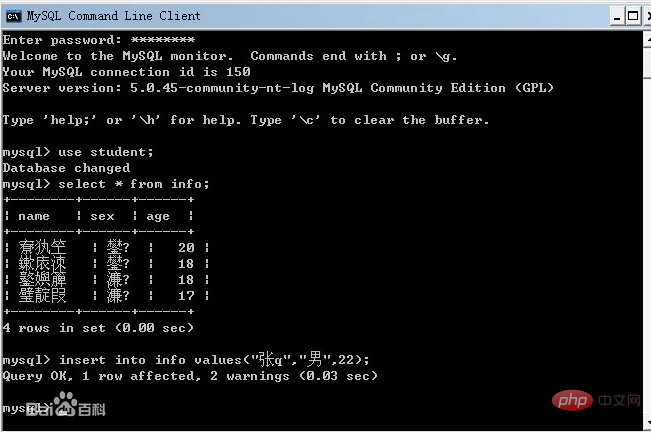What is the view of mysql
The view of mysql is an interface for storing data in the mysql database, which can also be said to be a virtual table; these data can be data from one or several basic tables or views, or user-defined data. ; When the data in the basic table changes, the data in the view changes accordingly.

The operating environment of this article: Windows 7 system, mysql version 5.0, Dell G3 computer.
What is the view of mysql?
mysql View
View is an interface for storing data in the mysql database
Introduction
View is an interface for storing data, which can also be said to be a virtual table. This data can be data from one or several basic tables (or views). It can also be user-defined data. In fact, the data is not stored in the view. The data is still stored in the basic table. When the data in the basic table changes, the data in the view changes accordingly.
Function
1. Mysql view makes the query very clear. The data stored in the view is the data we want, and it can simplify user operations.
2, mysql view makes data more secure. The data in the view does not exist in the view, but is still in the basic table. Through the relationship of the view, we can effectively protect our important data
Type
Mysql views have three types: MERGE, TEMPTABLE, UNDEFINED. If there is no ALGORITHM clause, the default algorithm is UNDEFINED. Algorithms affect how MySQL handles views.
1, MERGE, will merge the text of the statement that references the view with the view definition, so that a certain part of the view definition replaces the corresponding part of the statement.
2, TEMPTABLE, the results of the view will be placed in a temporary table, and then used to execute the statement.
3, UNDEFINED, MySQL will choose the algorithm to be used. If possible, it favors MERGE over TEMPTABLE because MERGE is generally more efficient and the view is not updatable if temporary tables are used.
Grammar
CREATE [OR REPLACE] [ALGORITHM = {UNDEFINED | MERGE | TEMPTABLE}]
VIEW view_name [(column_list)]
AS select_statement
[WITH [CASCADED | LOCAL] CHECK OPTION]
This statement can create a new view. If the OR REPLACE clause is given, this statement can also Replace existing view. select_statement is a SELECT statement that gives the definition of a view. This statement can select from a base table or other view.
This statement requires CREATE VIEW permission on the view, as well as certain permissions on each column selected by the SELECT statement. SELECT permission is required for columns used elsewhere in the SELECT statement. If there is an OR REPLACE clause, you must have DROP permission on the view.
Views belong to the database. By default, a new view will be created in the current database. To explicitly create a view in a given database, when creating it, specify the name as db_name.view_name.
mysql> CREATE VIEW test.v AS SELECT * FROM t;
Tables and views share the same namespace in the database, therefore, the database cannot contain tables and views with the same name.
Views must have unique column names without duplication, just like the base table. By default, the column names retrieved by the SELECT statement are used as view column names. To define explicit names for view columns, use the optional column_list clause, which lists IDs separated by commas. The number of names in column_list must equal the number of columns retrieved by the SELECT statement.
The columns retrieved by the SELECT statement can be simple references to table columns. It can also be an expression using functions, constant values, operators, etc.
Unqualified tables or views in the SELECT statement will be interpreted according to the default database. A view can reference a table or view in another database by qualifying the table or view name with the appropriate database name.
Recommended learning: "mysql video tutorial"
The above is the detailed content of What is the view of mysql. For more information, please follow other related articles on the PHP Chinese website!

Hot AI Tools

Undresser.AI Undress
AI-powered app for creating realistic nude photos

AI Clothes Remover
Online AI tool for removing clothes from photos.

Undress AI Tool
Undress images for free

Clothoff.io
AI clothes remover

AI Hentai Generator
Generate AI Hentai for free.

Hot Article

Hot Tools

Notepad++7.3.1
Easy-to-use and free code editor

SublimeText3 Chinese version
Chinese version, very easy to use

Zend Studio 13.0.1
Powerful PHP integrated development environment

Dreamweaver CS6
Visual web development tools

SublimeText3 Mac version
God-level code editing software (SublimeText3)

Hot Topics
 1378
1378
 52
52
 MySQL: Simple Concepts for Easy Learning
Apr 10, 2025 am 09:29 AM
MySQL: Simple Concepts for Easy Learning
Apr 10, 2025 am 09:29 AM
MySQL is an open source relational database management system. 1) Create database and tables: Use the CREATEDATABASE and CREATETABLE commands. 2) Basic operations: INSERT, UPDATE, DELETE and SELECT. 3) Advanced operations: JOIN, subquery and transaction processing. 4) Debugging skills: Check syntax, data type and permissions. 5) Optimization suggestions: Use indexes, avoid SELECT* and use transactions.
 How to open phpmyadmin
Apr 10, 2025 pm 10:51 PM
How to open phpmyadmin
Apr 10, 2025 pm 10:51 PM
You can open phpMyAdmin through the following steps: 1. Log in to the website control panel; 2. Find and click the phpMyAdmin icon; 3. Enter MySQL credentials; 4. Click "Login".
 How to create navicat premium
Apr 09, 2025 am 07:09 AM
How to create navicat premium
Apr 09, 2025 am 07:09 AM
Create a database using Navicat Premium: Connect to the database server and enter the connection parameters. Right-click on the server and select Create Database. Enter the name of the new database and the specified character set and collation. Connect to the new database and create the table in the Object Browser. Right-click on the table and select Insert Data to insert the data.
 How to create a new connection to mysql in navicat
Apr 09, 2025 am 07:21 AM
How to create a new connection to mysql in navicat
Apr 09, 2025 am 07:21 AM
You can create a new MySQL connection in Navicat by following the steps: Open the application and select New Connection (Ctrl N). Select "MySQL" as the connection type. Enter the hostname/IP address, port, username, and password. (Optional) Configure advanced options. Save the connection and enter the connection name.
 MySQL: An Introduction to the World's Most Popular Database
Apr 12, 2025 am 12:18 AM
MySQL: An Introduction to the World's Most Popular Database
Apr 12, 2025 am 12:18 AM
MySQL is an open source relational database management system, mainly used to store and retrieve data quickly and reliably. Its working principle includes client requests, query resolution, execution of queries and return results. Examples of usage include creating tables, inserting and querying data, and advanced features such as JOIN operations. Common errors involve SQL syntax, data types, and permissions, and optimization suggestions include the use of indexes, optimized queries, and partitioning of tables.
 MySQL and SQL: Essential Skills for Developers
Apr 10, 2025 am 09:30 AM
MySQL and SQL: Essential Skills for Developers
Apr 10, 2025 am 09:30 AM
MySQL and SQL are essential skills for developers. 1.MySQL is an open source relational database management system, and SQL is the standard language used to manage and operate databases. 2.MySQL supports multiple storage engines through efficient data storage and retrieval functions, and SQL completes complex data operations through simple statements. 3. Examples of usage include basic queries and advanced queries, such as filtering and sorting by condition. 4. Common errors include syntax errors and performance issues, which can be optimized by checking SQL statements and using EXPLAIN commands. 5. Performance optimization techniques include using indexes, avoiding full table scanning, optimizing JOIN operations and improving code readability.
 How to use single threaded redis
Apr 10, 2025 pm 07:12 PM
How to use single threaded redis
Apr 10, 2025 pm 07:12 PM
Redis uses a single threaded architecture to provide high performance, simplicity, and consistency. It utilizes I/O multiplexing, event loops, non-blocking I/O, and shared memory to improve concurrency, but with limitations of concurrency limitations, single point of failure, and unsuitable for write-intensive workloads.
 How to recover data after SQL deletes rows
Apr 09, 2025 pm 12:21 PM
How to recover data after SQL deletes rows
Apr 09, 2025 pm 12:21 PM
Recovering deleted rows directly from the database is usually impossible unless there is a backup or transaction rollback mechanism. Key point: Transaction rollback: Execute ROLLBACK before the transaction is committed to recover data. Backup: Regular backup of the database can be used to quickly restore data. Database snapshot: You can create a read-only copy of the database and restore the data after the data is deleted accidentally. Use DELETE statement with caution: Check the conditions carefully to avoid accidentally deleting data. Use the WHERE clause: explicitly specify the data to be deleted. Use the test environment: Test before performing a DELETE operation.




